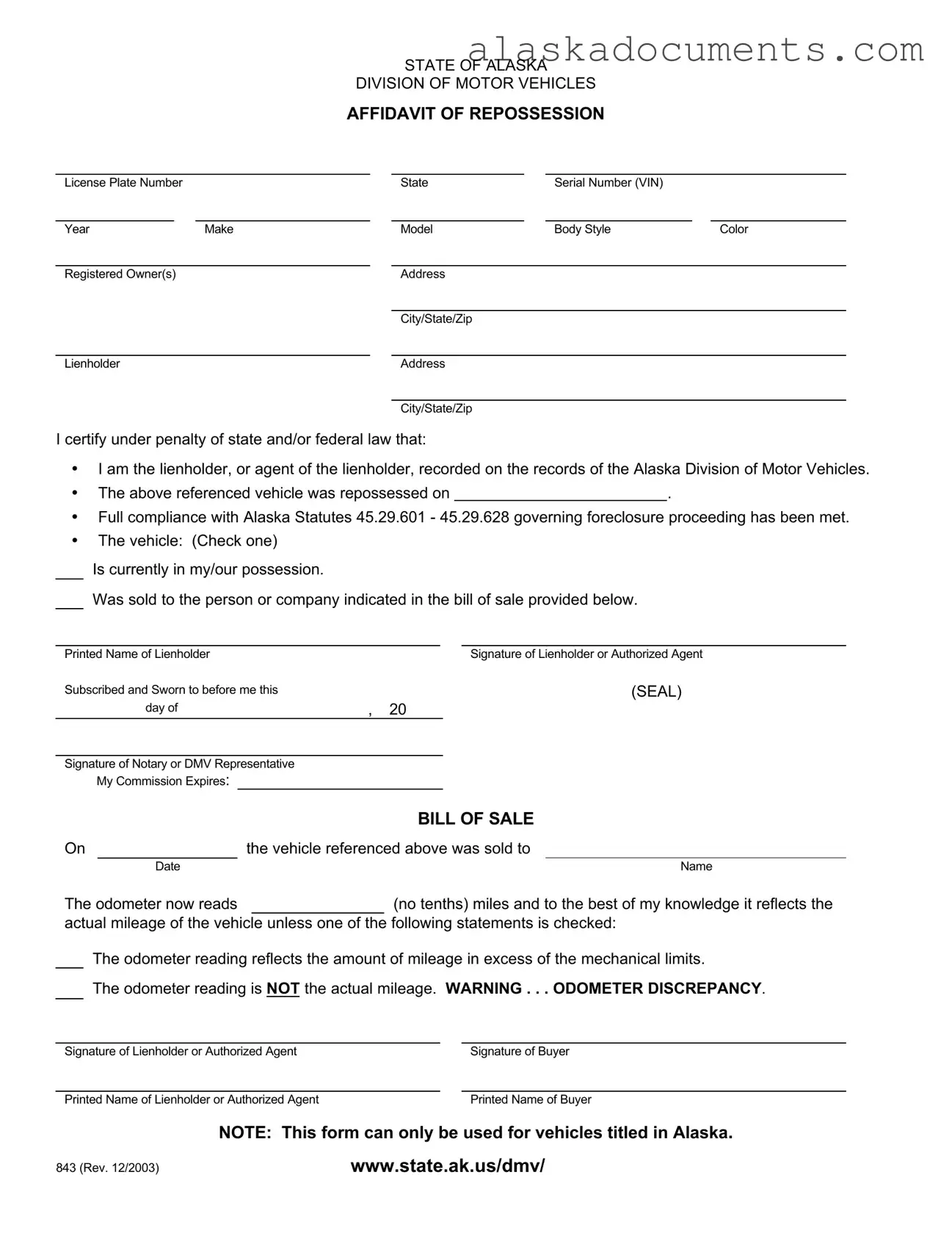The Alaska 812 form, known as the Application for Title & Registration, is similar to the Alaska 843 form in that both are essential for the transfer of vehicle ownership. The 812 form serves as the primary application to obtain a title and register a vehicle in Alaska. It requires information about the vehicle, including the make, model, and VIN, as well as details about the owner. Like the 843, it must be completed accurately to ensure compliance with state regulations. Both forms are integral to the process of legally establishing ownership of a vehicle within the state.
The Alaska 809 form, or Affidavit of Lost Title, is another document that parallels the Alaska 843 form. This form is used when the original vehicle title is lost and needs to be replaced. The 809 form requires the applicant to provide specific details about the vehicle and affirm that they are the rightful owner. Similar to the 843, it necessitates a notarized signature to validate the claim. Both documents play crucial roles in facilitating the transfer and acknowledgment of vehicle ownership under Alaska law.
The Bill of Sale is a document that shares similarities with the Alaska 843 form, as it serves as proof of the transaction between the seller and buyer of a vehicle. This document typically includes information such as the sale date, purchase price, and details about the vehicle. Like the 843, the Bill of Sale must be signed by both parties to be legally binding. Both documents are essential for establishing ownership and ensuring that the transaction complies with state regulations.
The Affidavit of Repossession used in other states can be compared to the Alaska 843 form in terms of purpose and function. This affidavit serves as a legal declaration by a lienholder that they have repossessed a vehicle due to non-payment or default on a loan. Similar to the Alaska 843, it requires the lienholder to certify that they are authorized to repossess the vehicle and that all legal procedures have been followed. Both documents are crucial in protecting the rights of the lienholder and ensuring compliance with relevant laws.
The Uniform Commercial Code (UCC) Financing Statement is another document that resembles the Alaska 843 form. The UCC Financing Statement is filed to perfect a security interest in personal property, including vehicles. Both documents require detailed information about the vehicle and the parties involved. They also serve to notify third parties of the lienholder's interest in the vehicle, providing legal protection for the lender in the event of default.
The Vehicle Title Application, while not specific to Alaska, is similar to the Alaska 843 form in that it is used to establish ownership of a vehicle. This application is often required in conjunction with other documents, such as the Bill of Sale or Affidavit of Repossession. Both forms aim to ensure that the ownership transfer is documented and legally recognized, preventing disputes over ownership in the future.
The California Articles of Incorporation form is a crucial document for businesses operating in the state, as it officially establishes a corporation and initiates its legal standing. This form captures vital information about the corporation such as its name, purpose, and details regarding its shares and initial agents. For more information, you can visit https://onlinelawdocs.com/california-articles-of-incorporation/.
The Release of Lien form also shares characteristics with the Alaska 843 form. This document is used to formally release a lienholder's claim on a vehicle once the debt has been satisfied. Similar to the 843, it requires signatures from the lienholder and often needs to be notarized. Both documents are vital in the process of clearing a vehicle title, ensuring that the new owner can obtain a clean title without encumbrances.
Finally, the Statement of Fact form is akin to the Alaska 843 form in that it can be used to provide additional information regarding a vehicle transaction. This form allows individuals to clarify circumstances surrounding the vehicle's ownership or history. Like the 843, it may be required in specific situations to ensure all relevant information is disclosed, thereby facilitating a smooth title transfer process.

